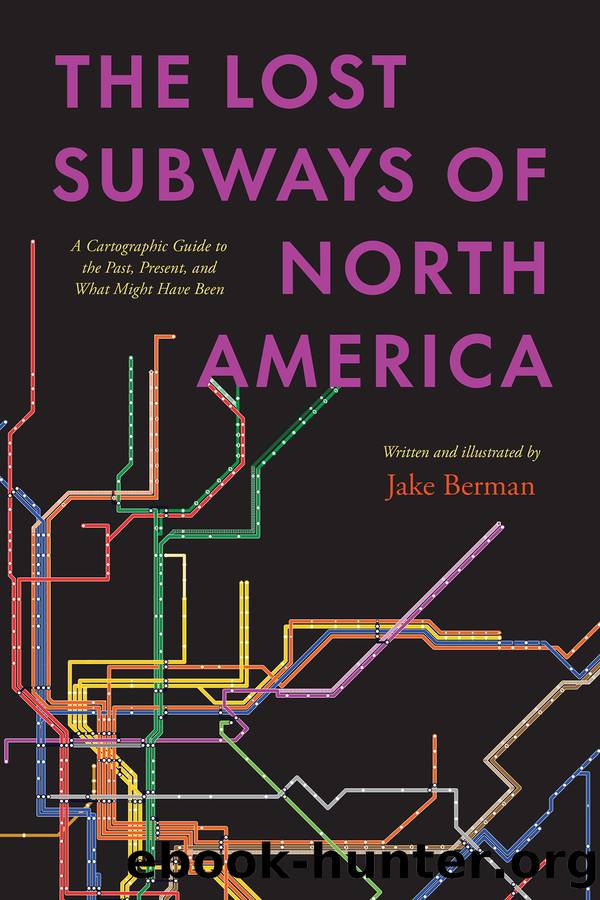The Lost Subways of North America by Jake Berman

Author:Jake Berman [Berman, Jake]
Language: eng
Format: epub
Tags: TRA000000 TRANSPORTATION / General, TRA009000 TRANSPORTATION / Public Transportation, TEC048000 TECHNOLOGY & ENGINEERING / Cartography, TEC009160 TECHNOLOGY & ENGINEERING / Civil / Transportation
Publisher: University of Chicago Press
Published: 2023-11-06T00:00:00+00:00
14.6 The MTAâs 1968 Program for Action. In the map, I have used the line-naming scheme proposed in 1968, so line designations do not match modern usage. Line T is the Second Avenue Subway.
The Most Expensive Piece of Subway in the World
In the 1990s, crime went down, the economy recovered, and New York City started its comeback. The graffiti was cleaned and the trains began to run on time again. The city and state once again had the financial stability to take another stab at building the Second Avenue Subway. The MTA board committed to building the full 10-mile line in 2000.16
Twenty-two years later, only 1.8 miles of two-track subway is complete. The cost has been $2.5 billion per mile, making it the most expensive piece of subway in the world.17 Per mile, New York paid two and half times what Los Angeles pays, six times what Tokyo pays, and 14 times what Milan pays.18 The challenges of building subways in New York City are not technological compared to these other cities. Los Angeles has earthquakes. Tokyo has earthquakes and is very densely populated. Milan is 2,500 years old, introducing archaeological and geological complexity. Rather, the challenges of building new subways relate to the MTAâs competence as an institution.
The most usual way of addressing governmental institutional failure is to hold officials accountable at the ballot box and through the other mechanisms of electoral politics. But itâs extremely difficult for New York City voters to hold officials to account for MTA failures. By law, the suburbs control one-third of votes on the MTA board. New York Cityâs mayor controls another third, and the state governor in faraway Albany controls the remaining third.19 The governor has effective day-to-day control, as the governor hires senior MTA management. The state legislature in Albany controls the purse strings. This governing structure means that city subway riders are subject to the whims of politicians who arenât accountable to city voters. This encourages political interference and incompetence.
Take the example of Andrew Cuomo. Cuomo took office as Governor of New York in January 2011. In May 2011, 85 percent of subway trains ran on time.20 In his first six years in office, Cuomo repeatedly diverted the MTA operations budget to fund unrelated projects, in one case using MTA money to bail out bankrupt state-owned ski resorts.21 Subway on-time performance collapsed, culminating in the 2017 âSummer of Hell,â when only 65 percent of trains ran on time, and two trains derailed.22 Taking political flak, Cuomo hired Andy Byford to run the subways. Byford, foremost transit operations expert in the English-speaking world, was CEO of the Toronto Transit Commission. The soft-spoken Englishman took control of the subways on New Yearâs Day 2018.
In Byfordâs two-year tenure, he began to clear the MTAâs decades-long repair backlog, greatly improving subway reliability in the process. But because the press gave Byford credit for this turnaround, rather than Cuomo, Cuomo stripped Byford of his authority in the summer of 2019.23 By early 2020, Byford was forced out entirely.
Download
This site does not store any files on its server. We only index and link to content provided by other sites. Please contact the content providers to delete copyright contents if any and email us, we'll remove relevant links or contents immediately.
| Acoustics | Bridges |
| Earthwork Design | Environmental |
| Fire Science | Highway & Traffic |
| Hydrology | Remote Sensing |
| Seismic Design | Structural |
| Structural Dynamics | Surveying & Photogrammetry |
| Transportation |
Whiskies Galore by Ian Buxton(41720)
Introduction to Aircraft Design (Cambridge Aerospace Series) by John P. Fielding(33017)
Small Unmanned Fixed-wing Aircraft Design by Andrew J. Keane Andras Sobester James P. Scanlan & András Sóbester & James P. Scanlan(32685)
Craft Beer for the Homebrewer by Michael Agnew(18082)
Turbulence by E. J. Noyes(7895)
The Complete Stick Figure Physics Tutorials by Allen Sarah(7267)
Kaplan MCAT General Chemistry Review by Kaplan(6823)
The Thirst by Nesbo Jo(6763)
Bad Blood by John Carreyrou(6477)
Modelling of Convective Heat and Mass Transfer in Rotating Flows by Igor V. Shevchuk(6354)
Learning SQL by Alan Beaulieu(6160)
Weapons of Math Destruction by Cathy O'Neil(6085)
Man-made Catastrophes and Risk Information Concealment by Dmitry Chernov & Didier Sornette(5878)
Digital Minimalism by Cal Newport;(5588)
Life 3.0: Being Human in the Age of Artificial Intelligence by Tegmark Max(5405)
iGen by Jean M. Twenge(5326)
Secrets of Antigravity Propulsion: Tesla, UFOs, and Classified Aerospace Technology by Ph.D. Paul A. Laviolette(5238)
Design of Trajectory Optimization Approach for Space Maneuver Vehicle Skip Entry Problems by Runqi Chai & Al Savvaris & Antonios Tsourdos & Senchun Chai(4957)
Electronic Devices & Circuits by Jacob Millman & Christos C. Halkias(4866)
